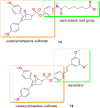Therapeutic significance of molecular hybrids for breast cancer research and treatment
- PMID: 36846377
- PMCID: PMC9945856
- DOI: 10.1039/d2md00356b
Therapeutic significance of molecular hybrids for breast cancer research and treatment
Abstract
Worldwide, breast cancer is still a leading cause of cancer death in women. Indeed, over the years, several anti-breast cancer drugs have been developed; however, the complex heterogeneous nature of breast cancer disease reduces the applicability of conventional targeted therapies with the upsurge in side effects and multi-drug resistance. Molecular hybrids generated by a combination of two or more active pharmacophores emerged as a promising approach in recent years for the design and synthesis of anti-breast cancer drugs. The hybrid anti-breast cancer molecules are well known for their several advantages compared to the parent moiety. These hybrid forms of anti-breast cancer molecules demonstrated remarkable effects in blocking different pathways contributing to the pathogenies of breast cancer and improved specificity. In addition, these hybrids are patient compliant with reduced side effects and multi-drug resistance. The literature revealed that molecular hybrids are applied to discover and develop novel hybrids for various complex diseases. This review article highlights the recent progress (∼2018-2022) in developing molecular hybrids, including linked, merged, and fused hybrids, as promising anti-breast cancer agents. Furthermore, their design principles, biological potential, and future perspective are discussed. The provided information will lead to the development of novel anti-breast cancer hybrids with excellent pharmacological profiles in the future.
This journal is © The Royal Society of Chemistry.
Conflict of interest statement
There is no conflict of interest to declare.
Figures








References
Publication types
LinkOut - more resources
Full Text Sources

